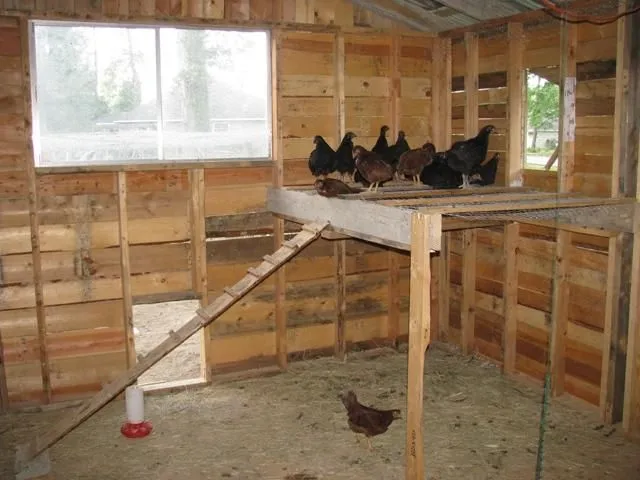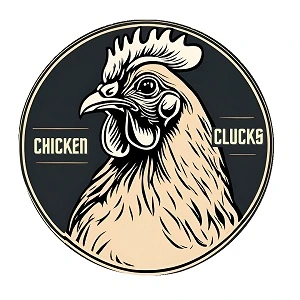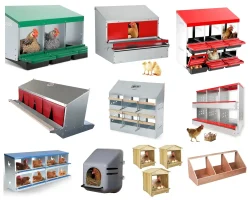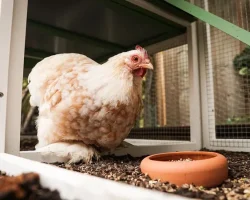Chicken roosts and perches are one of the most important features of any chicken coop for several key reasons. First, it helps maintain harmony amongst your flock because it helps birds to escape from more dominant hens. It’s also their instinct to perch at a higher level at night as a defence against predators. Meanwhile, according to scientific experts, including the European Food Safety Authority (EFSA), perches help promote bone health and other physical benefits. In this guide, we’ll examine why it’s essential to have perches in your hens’ coop and what science says are the best options. We’ll consider aspects including perch types, dimensions, placement, and safety tips.
Why Chickens Love to Roost
Chickens are domesticated birds, but they still share many traits with wild birds. They naturally roost at night because it protects them from predators, including foxes, raccoons, and coyotes. Quite simply, the elevation keeps them out of harm’s reach. Your birds may even panic at night if they don’t have an available perch. This can cause severe stress with many side effects, including feather loss and a refusal to lay eggs.
Researchers at the University of Georgia revealed that perches also reduce aggression in birds (via MDPI). Some chickens have stronger personalities than others and may bully their coop-mates. There are even reports of cannibalism amongst laying hens when their keepers don’t create the right environment for them. Perches help chickens to maintain social harmony, reducing the risk of feather pecking and other antisocial behavior. Also, when the birds defecate, their droppings will fall beneath them, rather than accumulating where they sleep.

Finally, perches also provide many physical benefits for your birds. Experts revealed that it helps with thermoregulation, which is important when the weather is excessively hot or cold. Hen perches also help with bone and muscle strength, as well as reducing the risk of health issues like footpad dermatitis and lesions.
Round vs Flat Perches? Choosing the Right Perch Shape
Many new hobbyists don’t realize that not all perches are the same. It’s important to consider the best perch shape for your chickens. Let’s look at the pros and cons of round and flat perches now.
Round Perches
Some hen owners prefer round perches because they are more similar to the branches a bird would use in the wild. They can easily grip the perch with their powerful feet, which in turn promotes muscle strength. Typically, these perches are also the cleaner choice. It’s a comfortable position for the birds, but there are a few issues to consider. First, the perch shouldn’t be too slippery or wide. If it’s too thick, your bird won’t be able to grip the bar. They may fall and suffer injuries, including broken bones or sprains.
Flat Perches
Flat perches are a common alternative to round perches. They offer a wider surface, so there’s less risk of the chickens falling and suffering keel bone injuries or deformities. This makes them a great option for older and less mobile birds. Flat perches offer a wider surface area, so the pressure on the keel bone is less, and they’re warmer for the birds in winter. This is because they can cover their feet fully with their bodies and maintain thermoregulation (via Applied Animal Behavior Science). The main disadvantage is that they tend to accumulate more droppings. Be prepared to clean more often if you use a flat perch!
What Is the Ideal Perch Width?
Ideally, perches are minimal 2.36 inches (6 cm) wide. To quote European Food Safety Authority (EFSA):
“There is no consistent evidence from the literature of a preference for perch width within the range of 1.5 to 10.5 cm. However, the experts’ opinion was that a perch width of 6 cm is better for bird welfare than a perch width of 3 cm (less good) or 1.5 cm (poor).”
How High Should Your Chicken Perches Be?
You might think that because your chickens have wings, it doesn’t matter how high you put their perch. However, this isn’t the case. We already mentioned the risk of injury when discussing round vs flat perches. It’s crucial to install the chicken perch at the correct height, too.
Most experts recommend a height of between 24-32 inches (60-80cm) above the floor for the lowest perch. Remember, this will vary depending on the breed. Rhode Island Reds are much bigger and more robust than bantams. Hens prefer it if you provide perches at different levels. In this case, you can build the other perches higher, since they can jump or fly from one perch to the other. There should be between 15 and 31 inches (40-80cm) spacing between perches in a multi-tier system. Putting the perches too close together is a recipe for disaster!
Meanwhile, you should ensure that there is a ceiling clearance of at least 8 inches (20cm) so that the birds don’t crash into the ceiling when they leave their perch. This may seem like an overabundance of caution, but chickens are susceptible to injuries, so we want to reduce the risk. Also, it is a waste of a good perch, since hens will probably not even use it if it is too close to the ceiling.

Ramps and Accessibility
Another way to improve accessibility is to install ramps. This is a wise option for older birds that lack the power to reach their perch. The ramp should be at 30-35 degrees so they can easily access it. It will drastically lower the chance of a senior bird falling and breaking or spraining a leg. However, a ramp may also expose your flock to predators, so always lock up the coop at night!
How Many Perches Do You Need?
The short answer to this question is that it depends on the number of chickens in your backyard flock. Also, the number of perches is not important; total perch length and the number of perch levels is important. Perches should have a minimum length of 8 inches (20 cm) per hen so your chickens have enough space.
Multi-tier systems are advisable because it is a more efficient use of space. Usually, this involves placing the food, water, and the perches at different levels. These systems help ensure there is enough perch space per chicken. It’s also a good way to separate dominant birds from more passive chickens. The more dominant birds will often perch at the highest perch, and more submissive or lower-ranking birds on the lower perches. This reduces stress.
As a general rule of thumb, a coop should have at least two perch levels for 2 to 10 hens. If you have more hens, you can add more perch levels if it fits in your coop and run. Preferably 3 levels for flocks of 10-20 hens, and 4 levels for more than 20 hens.
Safe Materials and Perch Installation
Hobbyists should also consider the material they want to use for their perch. Plastic, wood, and coated metal are the most popular.
Wood
Wood perches are very popular because they have a lower risk of keel deformations (via Poultry Extension). However, wood, like plastic, is susceptible to red mite infestations, and these can impact your chickens.
Plastic
Plastic is less popular than the other options because it’s not as robust. However, it’s also less likely to experience weathering, which is a key advantage. My recommendation is wood unless there’s a genuine risk of red mite infestations.
Metal
Iron tube perches are more common in commercial poultry farms because they are easy to clean, robust, and less prone to pest infestations. However, they also slippery and hard, and have higher rates of keel injuries and bone fractures from chickens falling.
Surface Conditions
Other points to consider are that the materials shouldn’t be too rough or smooth. However, this shouldn’t be an issue if you sourced your perches from a reputable vendor. One top tip is to secure the perch at each end so that it doesn’t spin or move out of place. Your birds should have free movement and be safe from predators! Also, most hobbyists will want the area to be easy to clean. That’s why removable perches are increasingly common now.
Perch Placement and Coop Design Tips
Perch placement is a key aspect of coop design. A little bit of careful consideration can reduce the risk of chaos! First, don’t put perches above your birds’ food and water. Otherwise, they will defecate into the containers, and this can cause health issues. It also means more work for the hobbyist because it will be necessary to clean them.
There should also be plenty of natural light and airflow in the coop for your birds. Remember, this may vary throughout the year depending on the seasons. It’s also important to space the perches out so the chickens aren’t on top of each other. It should be possible for them to move freely. This lowers the chance of feather-pecking incidents (via University of Maryland). If you’re looking to save floor space, consider getting a high coop because you can use the vertical space for perches. Higher coops are also easier on your back.

Encouraging Chickens to Use Perches
Usually, chickens will instinctively use perches without any need for encouragement. But sometimes they may need a little extra help. Placing a perch lower to the ground can help them to recognize it is there and become familiar with it. Gradually raise the level to the appropriate height for your birds.
Another tip is to install a perch near the nesting boxes. This will encourage roosting, and they’ll likely take to it quickly. You could always sprinkle some chicken treats, like seeds, on the perch to trigger their immediate interest.
Common Perch Problems and How to Solve Them
Some hobbyists experience common perch problems. Luckily, it’s usually easy to solve them quickly.
Overcrowding
Overcrowding is one of the most frequent issues. This usually means that you need to introduce more perches for your backyard flock. If there isn’t room inside your coop, you need to invest in a bigger space for your birds. Remember, there should be at least 8 inches (20 cm) per hen of perch space!
Injuries
Foot injuries are the most common perch-related malady. Avoid these by using the appropriate-sized perch for your hen breed. If the diameter is too wide, they won’t be able to grip the perch properly. Also, if the surface is too smooth or rough, it can reduce their stability. It may be necessary to replace perches over time.
Aggression
Aggression is another major issue. This is usually a side-effect of overcrowding, so again, ensure there are enough perches for your birds. Raise the lowest perch so it’s too high for chickens on the ground to peck roosting hens. A multi-layer system is probably the best option if you have a couple of dominant chickens.
Conclusion: Science-Backed Tips for Happy Chickens
The good news is that installing a chicken perch is relatively straightforward. In this guide, I’ve provided science-backed tips to help ensure it’s a safe and happy experience for you and your birds. Keep your hens safe by placing your perch at the right height and the appropriate spacing. The correct shape is also important, so there’s less risk of injury.
Don’t forget to monitor your flock’s activity so you can identify if there is any unusual or concerning behavior. Chicken coop safety is something that should never be taken lightly. As hobbyists, we should know all about our hens from winter roosting to egg binding, so we can keep them in good health!





